- INTRODUCTION
- LECTURES
- Critical practices in the Architecture of the Baltic Region / An Introduction by Lolita Jablonskienė
- Ieva Zībārte / Uncensored Admiration. 10 Quiet Forms of Dissidence in the Life and Work of the Architect Marta Staņa
- Ingrid Ruudi / Critical Architecture between Prestroika and Independence? GROUP T Architects in Tallinn
- Marija Drėmaitė / Critical Practices in Lithuanian Architecture of the Soviet Period
- Andres Kurg / The Papers, Exhibitions and Buildings of the Tallinn School in Estonia
- Ivan Ristić / Bogdan Bogdanović – the Practice of Architecture under Changing Political Regimes in Yugoslavia
- INTERVIEWS
- ESSAYS
- Tor Lindstrand, Håkan Nilsson / Staging Subversive Opportunism in the Age of Feedback Loop
- Manuel Bürger / Slipping Through Templates. Limitation as a Tool of Control - A Design Observation
- Ethel Baraona Pohl / Emancipatory Architecture
- Jack Self / The Only Task of Architecture
- Eray Çayli / Turkey’s Construction Boom as Opportunity and Publicness as Medium of Subversion
- ABOUT
ALF 04
Ivan RISTIĆ. BOGDAN BOGDANOVIĆ – THE PRACTICE OF ARCHITECTURE UNDER CHANGING POLITICAL REGIMES IN YUGOSLAVIA
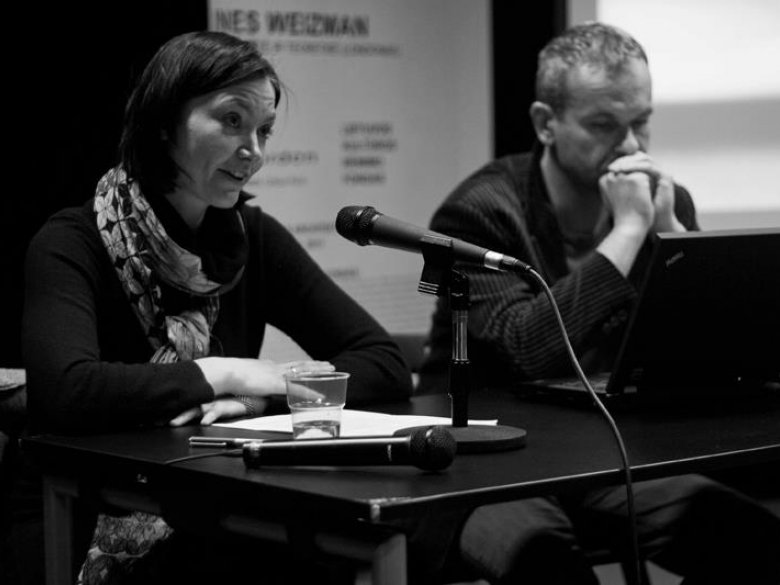
Ivan Ristić (right) and Ines Weizman at National Gallery of Art, Vilnius, 2013. Photo:
First of all thank you for inviting me. Why Bogdan Bogdanović? I come from Belgrade, some of you may know that Bogdan Bogdanović was a mayor of that city between 1982 and 1986, so a vast majority of the contemporaries does not really believe that he might have been a dissident under the communist regime. This is one of the most interesting aspect of the phenomenon Bogdan Bogdanović – being a dissident without being a dissident. This is what we are going to talk about this evening.
I met Bogdan Bogdanović in 1993, paradoxically not in Belgrade – our hometown – but in Vienna where we both lived in exile. By that time, I had already known a couple of things about him, I had also read some of his books. In these books he mainly concentrated on city planning and was highly interested in all the problems considering the city, he reflected a lot on the metaphysics of the city by examining its position and character in today’s world. Furthermore, he developed a very special kind of poetry of the cities without ceasing to be a scholar.
Gordana Fontana-Giusti who is missing this evening wrote an essay about Bogdan Bogdanović’s book called “The Futile Trowel”. It is a book which appeared first in 1963, in which Bogdanović delivered an imaginative polylogue with the masters from the past like Bernini, Borromini, Guarini, Piranesi and others. I have to emphasize that in his youth Bogdan Bogdanović actually was a surrealist. He attended the second gymnasium in Belgrade in the late 1930s. Many of young people were actually influenced by surrealism. I’m talking of course about Bretonian group, not about Aragonian group which was rather Stalinist. Bogdan Bogdanović however kept considering himself a Trotskyist, which is I think a very important thing to emphasize – also in a context of the later socialist Yugoslavia.
He was born in 1922 into a family of left-wing intellectuals in which the written word was held in high esteem. He actually wanted to become a writer, but not only a writer – at some point he realized that building also meant a creation of some kind of text. His favourite slogan was “I wrote so that I could build and I built so that I could write”. So he never separated those two things from each other and I may also remind of the famous statement by Adolf Loos, according to which a good architecture is the one which can be told about, which can be described. This is something Bogdanović was arguing about in many of his essays.
During the WWII he joined the partisans and became a member of the Communist Party of Yugoslavia. He was even more than that: he was a soldier of the Party (as he aptly put it), but still a dissident. It might sound peculiar, but maybe we are going to realize how and why in the course of this lecture.
He completed his studies in 1950. His tutor was Nikola Dobrović, a prominent protagonist of Yugoslavian Modernism who had lived in Prague back in 1920s, who knew Jan Kotěra and a number of his influential contemporaries. After having finished his studies Bogdan was a bit desperate, he did not really know how to turn his ideas into the practice. We must be aware of the fact that he had planned surrealist houses in his youth – houses without doors and windows, houses with stairs which lead nowhere and other weird features partly reminding of Tristan Tzara’s phantasies.
The so-called real life was a harsh thing to deal with. Expectably, the building authorities in socialist Yugoslavia did not grant much leeway for the architects. There were for example only two types of windows allowed. Bogdan got quite desperate with this situation and was soon forced to find a niche within his practice. One of the first projects he worked on was a housing estate near Belgrade called “Jaroslav Černi”. It all happened far away from any big gestures of socialist urbanism. These are not big houses, the settlement looks rather like a Mediterranean village. The window frames were made of concrete, thus contrasting with the rough surface of stone façades. Bogdanović emphasized that those where thought of as windows in Platonic sense. The Windows - they cannot be more “windowish”. Of course, the whole settlement turned out to be completely unpractical. I paid a visit to “Jaroslav Černi” couple of years ago and the people who lived there complained about various disadvantages of their homes. The houses might be suitable for summer holidays, but not for permanent domiciles. Bogdanović was aware of this fact and this is what drew him away from the architectural practice.
 „Jaroslav Černi“ Housing Estate, Belgrade (1953). Photo: Ivan Ristić
„Jaroslav Černi“ Housing Estate, Belgrade (1953). Photo: Ivan Ristić
So what was the niche, what was the big discovery of his life? The monuments. We all know what the monuments are. The monuments are supposed to remind us of historical events and to reveal dark secrets, but they often do exactly the opposite: by telling only one story in only one single symbolical language, they somewhat hide the truth. Bogdan Bogdanović realized that he might express himself in this media of architectural monument by enabling the visitors to read the messages on many different levels. Without creating or modelling some partisans with bombs, without making big late Modernist gestures, he succeeded in transmitting his personal poetry into these monuments which are often urban-amorphous.
He was strongly focused on a drawing as a medium. Typically enough, he drew many of his projects after the execution, however not in order to improve or remodel them, but to make some further reflections on the subjects. So this is how the architecture actually continued in his mind.
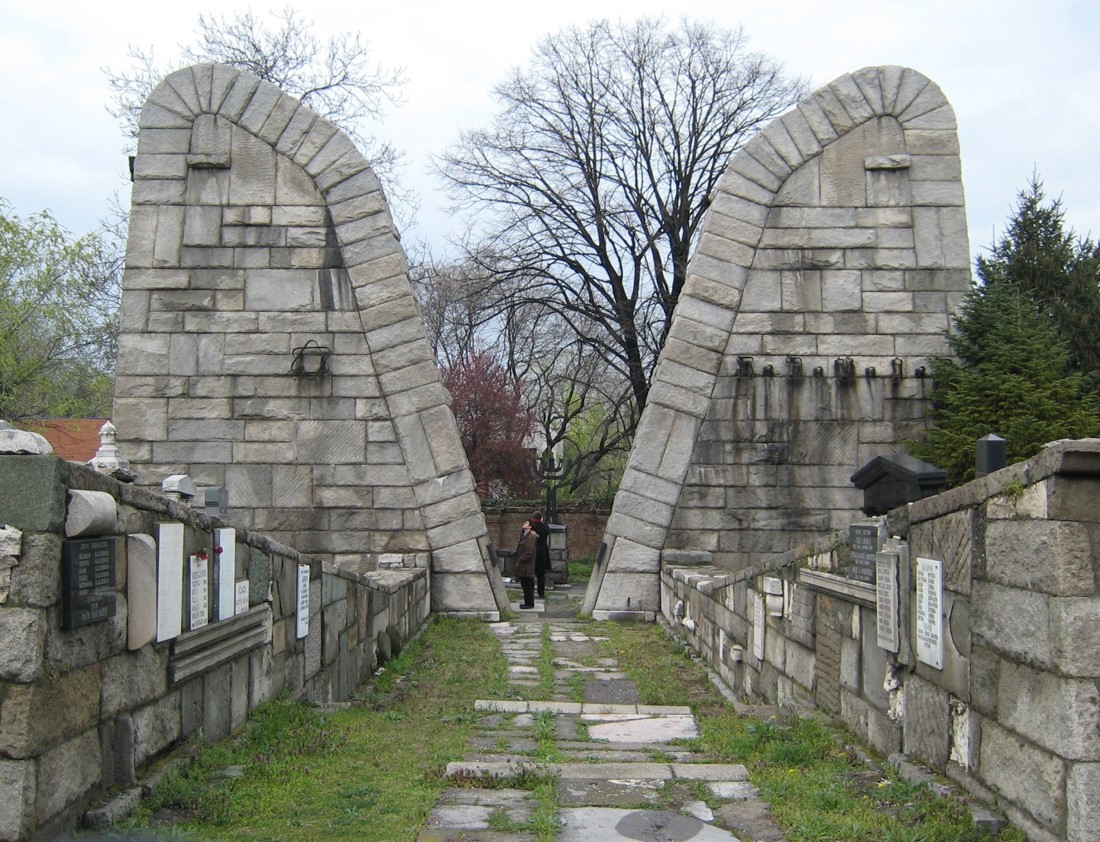 Memorial to the Jewish Victims of Fascism, Belgrade (1952). Photo: Ivan Ristić
Memorial to the Jewish Victims of Fascism, Belgrade (1952). Photo: Ivan Ristić
Memorial to the Jewish Victims of Fascism in Belgrade (1952) was the first monument built by Bogdan Bogdanović. It was commissioned by the Jewish community. There were six or seven competitors, the commissioners however decided to accept Bogdan Bogdanović’s proposal mostly because it contained no ideological signs – there are no stars, hammers or any emblems of that sort. Initially Bogdan wanted to build this monument in reinforced concrete, but the representatives of the Jewish community wouldn’t accept this modern material. They insisted on importance of stone for their religion. In the course of their march to Jordan, each exponent of the Jewish tribe had to bear a stone as an element of the lost arch. This is the symbolical level of architectonical appearances Bogdanović was quite fond of. On the walls which flank the “dromos” (a path leading to the big gate) we notice some remnants of the houses in Belgrade which had been destroyed during the bombardments in the WWII. So they were deployed as spolia (an archaeological term meaning re-use of earlier building material or decorative sculpture by incorporating it in new architectural compositions).
What is the symbolism of the gate? As for Bogdan Bogdanović, it was a gate into a new kind of architecture, a discovery. I also have to draw your attention to the shape itself. You can observe oblique outlines of the core of the monument. The void space formed by the two wings seems to open up against the sky. It is an imaginary drawing defined by Bogdanović as anti-perspective, suggesting a mirroring effect. Some further attempts to interpret these monuments were made as well - wings of Ariel for instance, or the two tablets of Moses. So what I am basically talking about is an “open system”, everybody is allowed to offer his or her own explanation of this model. Bogdan never really postulated any definite formulas about how to read his monuments.
Like many of his contemporaries Bogdan Bogdanović was initially a Corbusean. He partly used the Le Corbusier’s Modulor in order to demonstrate how the monument acts in the space. However he gave up this practice quite soon, in the late 1950s.
The monument itself was vastly ignored by the press, there was but a short article in an architecture magazine published in Ljubljana. Bogdan became and also remained a “respectably ignored” person in the following decades. Therefore he decided to focus on his activities at the University of Belgrade. He worked for the Department for urban development, giving lectures on the history of the city and writing essays. Apart from these activities he saw no chance to deploy his skills. It was not until 1959, when he was commissioned with big projects. Paraphrasing the case of Joseph Emanuel Fischer von Erlach, we might describe the 1960s as the big decade of Bogdan Bogdanović. His most impressive and most important works were made in that period.
Speaking about the Jewish monument I also have to mention few more aspects. Look at these wings again. In some official proposals for the Jewish community they were described as stećci. Stećci ist how the Bogomile gravestones from Bosnia are called. People who created this kind of primitive art in the 15th century were neither Orthodox nor Catholics, they were Heretics similar to the Albigensians in France. They became rather popular with communist ideologists in the Afterwar period. It should have become a Yugoslavian compromise in a certain sense – being neither orthodox nor catholic, i.e. neither Western nor Eastern. I may remind you that Tito had made his break with Stalin in 1948 and that Yugoslavia belonged neither to the Eastern nor to the Western bloc. The “third path" became a trade mark of Yugoslavian ideology and also increasingly popular with cultural activists. The fact that the first monument by Bogdanović had no similarities with “stećci” whatsoever didn’t seem to bother anyone.
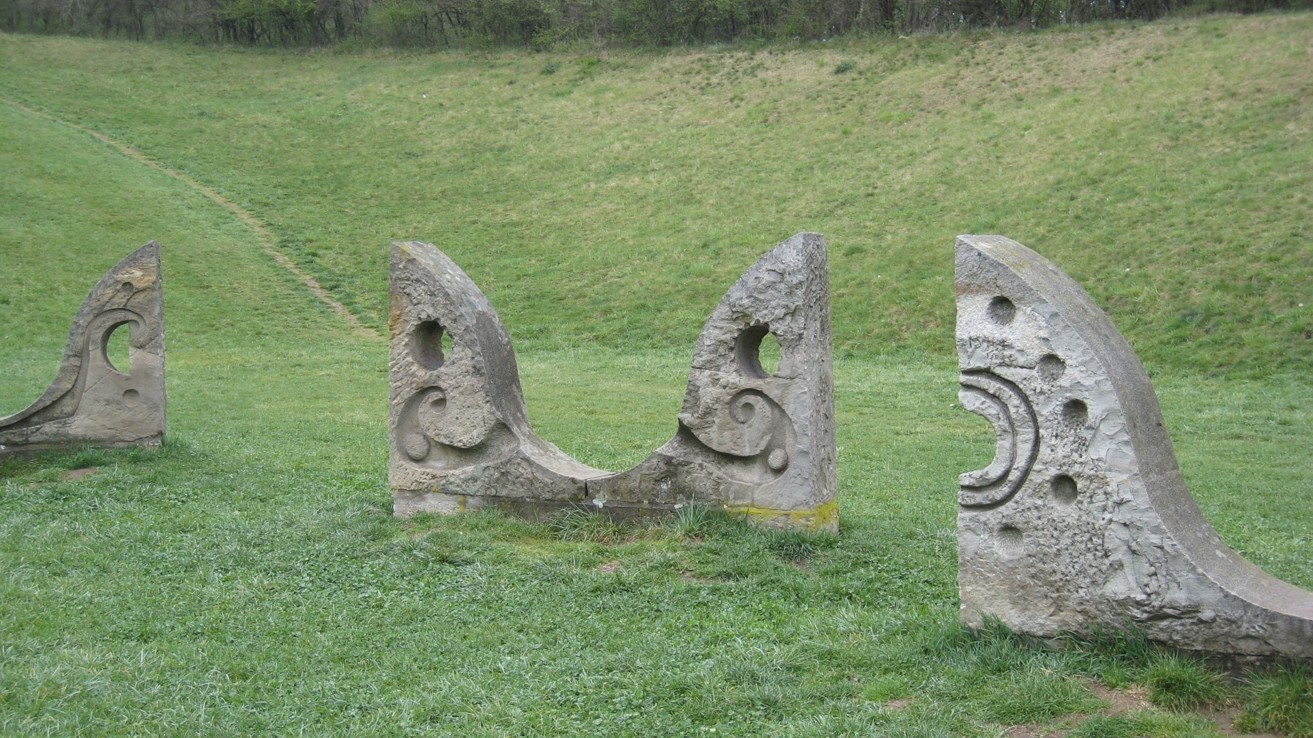 Slobodište, Kruševac (1965) The Valley of Tribute. Photo: Ivan Ristić
Slobodište, Kruševac (1965) The Valley of Tribute. Photo: Ivan Ristić
“Slobodište” in Kruševac, Serbia, was one of the most ambitious projects in the 1960s. “Slobodište” means more or less “freedom site”. It was completed in 1965. If I recall correctly, the first works by land artists like Smithson and others. were made in late 1960s. That would probably mean that Bogdanović invented the Land Art before Land Art and it is quite a unique thing. How did he come to this solution? In the first place, he didn’t find the site particularly motivating, as it was rather flat. Luckily, there was a factory in Kruševac that produced bulldozers. They representatives of this enterprise needed a place where they could try out the machines. Bogdanović got the idea to let them exercise the machines by remodelling the landscape according to his drawings. This is exactly what happened – Bogdanović developed a site consisting of two big valleys, the so-called “Valley of Commemoration” in the upper part, and in the lower part featuring a summer stage. The latter is quite typical for communist planning – if there was a memorial site, some summer stages were often incorporated to the site in order to have some theatre productions performed there. It is really an impressive place of about 180 meters length. In the last planning phase Bogdanović decided to add the stone “wings” which more or less look like remnants of some vanished civilization. Some other details can also be found like, for example, millstones, on which you can read “Bread and freedom are the same thing to us”. This is actually quite a kitschy message. There were some influential personalities who strongly interfered in this concept. I am talking about Dobrica Ćosić, who later became a big Serbian nationalist, who was also a great companion of Tito, and the member of Communist Party, etc.
Once I reminded Bogdanović of the fact that these curves of wings are slightly similar to those considered by William Hogarth a perfect line. Bogdanović said to me: “Well it is possible, I did not know about this curve by Hogarth, but wise people understand each other without even having met each other, this is how it is”. Some years later, in 1974, in Štip, Macedonia, this motive was re-used. Here they appear more elegant and we also recognize some symbols, so it looks quite oriental altogether. It is not by chance he made it in Macedonia, a land in which the old oriental crafts really have a long tradition, as the land was ruled by Ottoman Turks for many centuries. And this is something Bogdanović accepted and embraced in his own sketches and designs. The point was that he respected the original tradition. And that he always tried to create some kind of connection with it. This was the case in Štip.
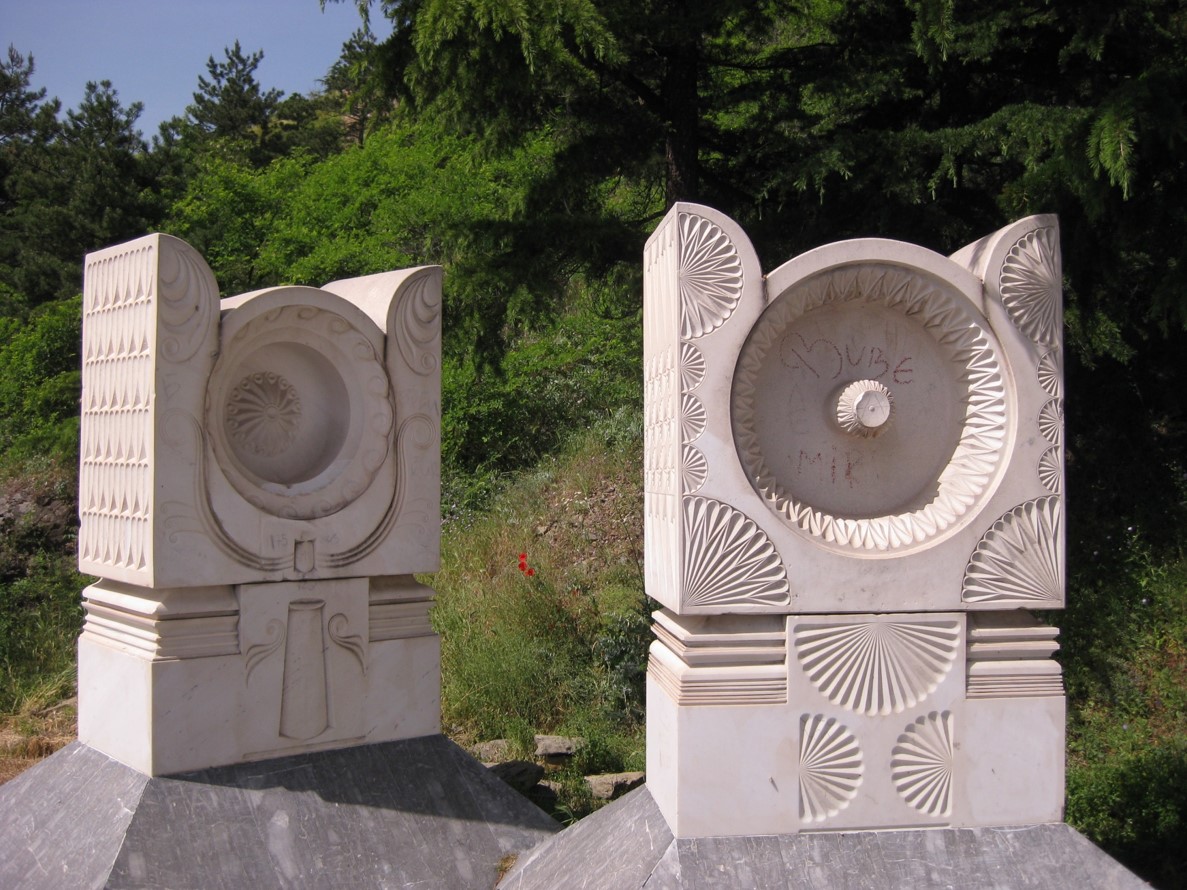 Soldiers Cemetery, Štip (1974). Photo: Ivan Ristić
Soldiers Cemetery, Štip (1974). Photo: Ivan Ristić
His most famous monument, completed in 1966, is the Memorial for the Victims of Concentration Camps in Jasenovac, Northern Croatia. Jasenovac was also called the Auschwitz of the Balkans. In 1941, the so-called Independent State of Croatia was established by Croatian fascists, the Ustaše, who were strongly supported by Adolf Hitler. There was a concentration camp on the site of the former brick works and it developed to the biggest concentration camp in Croatia during the WWII, where tens of thousands of Serbs, Jews, gypsies and anti-fascists of different ethnic groups were tortured and eventually killed. Yugoslavian establishment hesitated for a long time before the final decision was made, for the crimes have not been committed by some foreign fascists, Germans or Italians, but by domestic fascists. Therefore it was quite a tricky thing to build such a monument on Croatian soil and Bogdanović proposed a compromise which, as you can see, did not really offend anybody, did not threaten anybody, but also did not hide the truth. This is a lyric monument, you can recognize a big flower. There are various interpretations - some describe the monument as a dome of gothic cathedral or a cosmic tree. Bogdanović, as I already hinted, welcomed all that; we are talking once again about the open system. This “tree” is 26 meters high, made of reinforced concrete. It seems to rise out of water. In this context, it is worth mentioning that Bogdanović at some point tried to classify his own monuments according to the elements. So there is the element of water, there is the element of earth. We saw an element of earth on Kruševac. This kind of spiritual games was quite typical for Bogdanović’ practice.
 Memorial to the Victims of Concentration Camps, Jasenovac (1966). Photo: Ivan Ristić
Memorial to the Victims of Concentration Camps, Jasenovac (1966). Photo: Ivan Ristić
In the course of my work at the Architekturzentrum in Vienna I tried to reconstruct the morphology of each single monument by classifying the drawings of Bogdanović and trying to imagine how they had developed. They look quite different sometimes. In certain cases we are dealing with the element of fire, which is also something extremely important for the aesthetics of Yugoslav politics. The fire was the main motive of Yugoslavian coat of arms. The six pieces were supposed to symbolise six republics of Yugoslavia: Macedonia, Serbia, Montenegro, Bosnia and Hercegovina, Slovenia and Croatia. And the unity of all these elements, of course, was designed after a Soviet model. Bogdanović however rather brought it into connection with the libertarian thought of the French revolution. He always found some possibilities of explaining his monuments in a way which did not necessarily correspond to the dictate of the communist discourse, however by being in accordance to the ruling ideology as well.
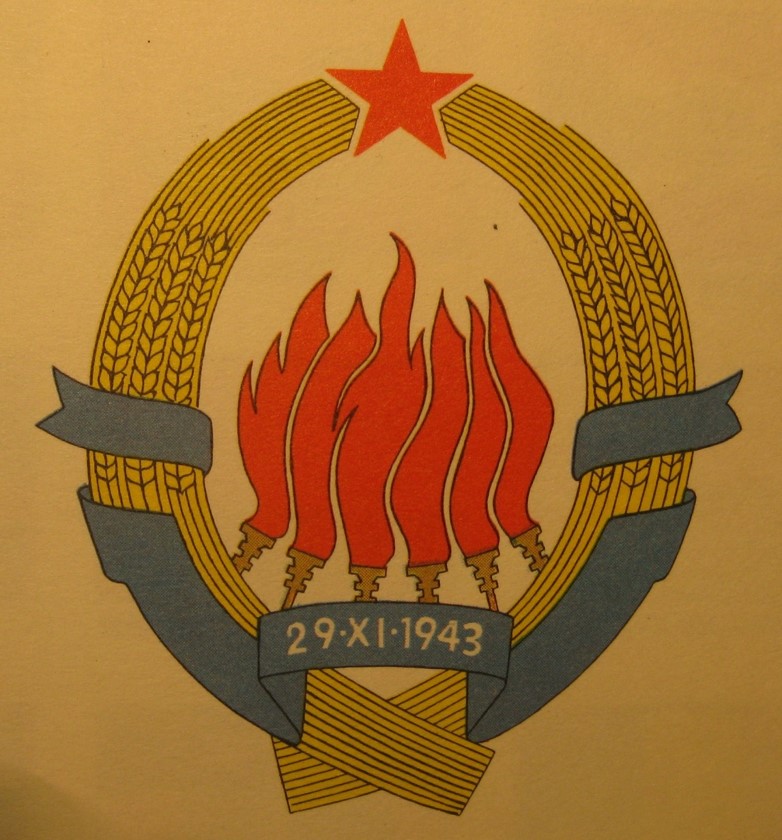 Coat of arms of the Socialist Federal Republic of Yugoslavia. Ivan Ristić
Coat of arms of the Socialist Federal Republic of Yugoslavia. Ivan Ristić
Bogdanović also liked to stress that his monuments were female; in Serbian language the word “monument” is actually masculine. He tended to consider the female a symbol of continuity and rebirth. Making the phenomenon of rebirth a main issue was of some importance, as he dedicated all his monuments to the victims of fascism and to those who were fighting against fascism during the WWII, and this notion of rebirth and eternal youth was also welcomed by the representatives of communist ideology.
There is an exception though. Cenotaphs in Bela Crkva were being considered masculine by Bogdanović. The site was inaugurated on the 7th of July, 1971, on the occasion of the 30th anniversary of the uprising of the Serbian communists against German occupation. In terms of choosing the style this matter was also a political one, as in the early 1970s, the Serbian communist party was ruled by the so-called liberal wing. These “liberals” rather had a friendly attitude towards Western democracies, they were anti-Stalinists, actually. But the communists from other parts of Yugoslavia considered them Serbian nationalists. I mention that because some typical motives of Serbian traditional clothes are being used for this monument. The hat called “šajkača” is crowning each of the cenotaphs.
We might also consider this manner a fine example of the so-called Socialist Aestheticism, which is something typical Yugoslavian. The doctrine of the Socialist Aestheticism was originally formulated by the literature critic Sveta Lukić in the early 1960s, then reformulated by some art critics in the 1970s. Being a progressive alternative to the Socialist Realism, the Socialist Aestheticism allegedly provided freedom in achieving sublime expressions. According to the postulates of Socialist Aestheticism, this very autonomy within the work of art should be the goal of an artist who thought and lived like a socialist individual. However paradoxical it might sound, the aim was actually to set one’s mind free in order to be a better communist. The comfortable aspect of this situation is that you can interpret it in many different ways. Bogdanović also partly embraced the aesthetic of the Soviet model, according to which “a work of art should be national by its shape, but socialist by its content.”
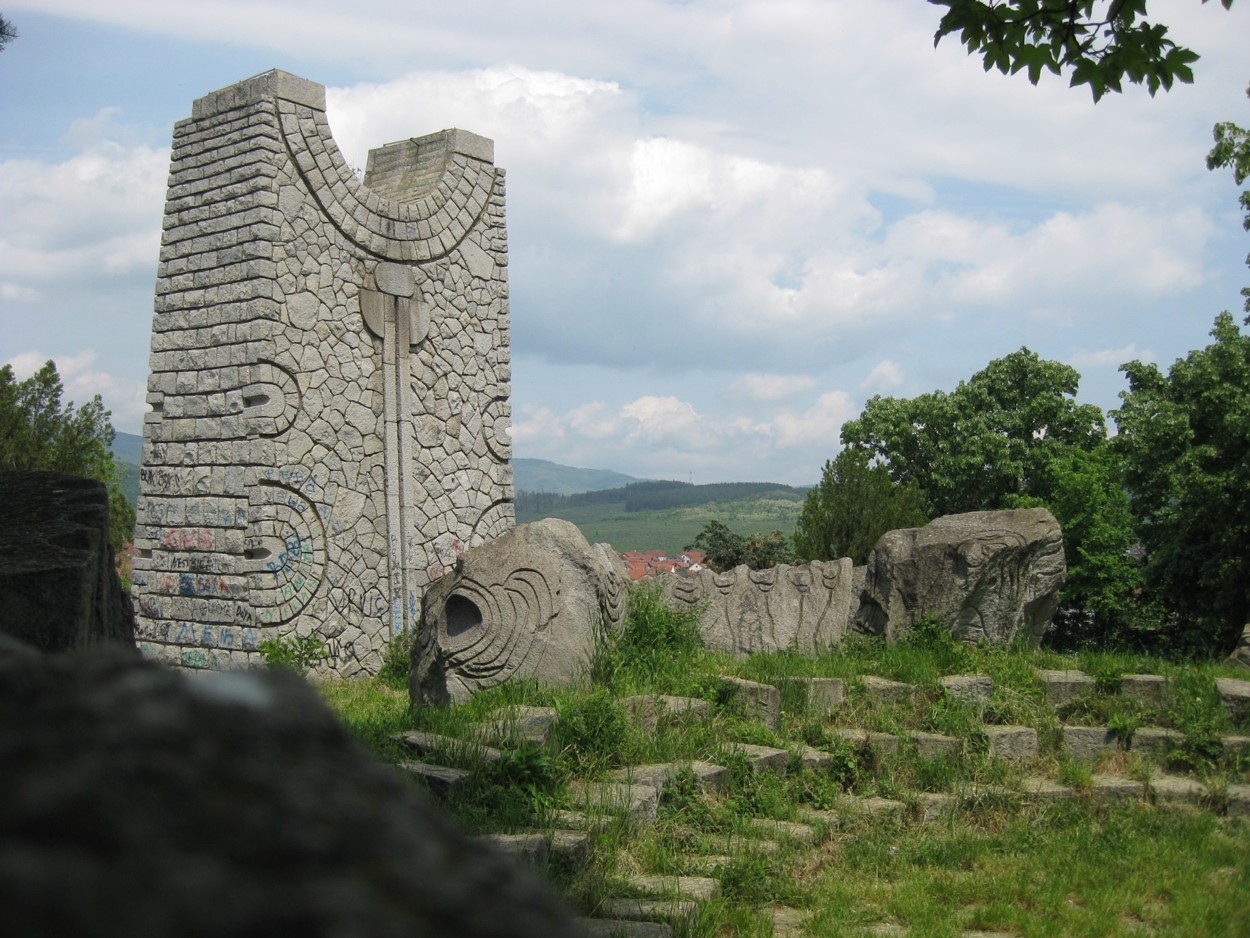 Cult Site for the Fallen Freedom Fighters, Vlasotince (1975). Photo: Ivan Ristić
Cult Site for the Fallen Freedom Fighters, Vlasotince (1975). Photo: Ivan Ristić
One more “gate” can be found in Vlasotince, Southern Serbia, built in 1975 and called “Cult Site of the Fallen Freedom Fighters”. It really gets difficult to believe that we are dealing with a monument dedicated to the partisan combatants during the WWII. You can easily recognize that Bogdanović referred to Neolithic art – just look at the carvings on the stones. He always stressed that he felt the most “at home” while researching the Neolithic period, also by consulting Sigfried Giedion’s “The Eternal Present”. Such granite stones are extremely difficult to get carved. The planning process was also a very long one. There are most various sketches proving again how manic Bogdanovć was in terms of searching for a proper formula. There were almost no execution plans. Bogdanović always kept the sketches hidden from his commissioners, in order to be able to develop and re-develop the ideas on and on in his studio. Of course, at some point they had to be realised. He highly appreciated the skills of his stone masons. This archetypal dimension of architecture also played a very important part. On a very abstract level, the monument of Vlasotince is also something like a gate opened towards the sky, it contains a solar symbol. The outlines of a cosmic plant can be recognized as well.
 Partisan Necropolis in Mostar in 2009. Photo: Ivan Ristić
Partisan Necropolis in Mostar in 2009. Photo: Ivan Ristić
Some sites are obviously based on urban-amorphous plans. One of the most radical interventions within the landscape was the Partisan Necropolis in Mostar, Hercegovina. Bogdanović actually created an abbreviature of a town featuring ramparts, gates, towers and narrow Mediterranean streets. The Necropolis is dedicated to 810 antifascists killed during the WWII, all of them from Mostar and its environments. The monument is also being described as Acro-Necropolis, which off course is a syllogism. Bogdan often created new words in a good old surrealist tradition. Acro-Necropolis – the city of the dead – was supposed to get into a dialogue with the city of the living ones. Unfortunately, this monument was severely damaged during the wars in Yugoslavia in the early 1990s. In this context, I have to draw your attention to the fact that Mostar is a divided city – divided between Bosnians in one part and the Croats in the other part. The misfortune of this monument was that it was situated on the Croatian side of the city and the Croatian nationalists were basically those who made all these damages. Currently some attempts are being made to reconstruct it. The problem is that stone masons from the 1960s do not live anymore and moreover that the craft as such does not exist. The whole site is crowned by a ziggurat on the top. It is backed by a circle contenting solar symbols. Bogdanović however didn’t take this esoteric symbolism seriously, he rather made fun of it. One more urban-amorphous scheme is “Memorial to the Fallen of the Wars of Independence between 1804 and 1945”, in Knjaževac, Serbia. 1971. In this case Bogdanović referred to the traditional xylography, treating the stone as if it was timber.
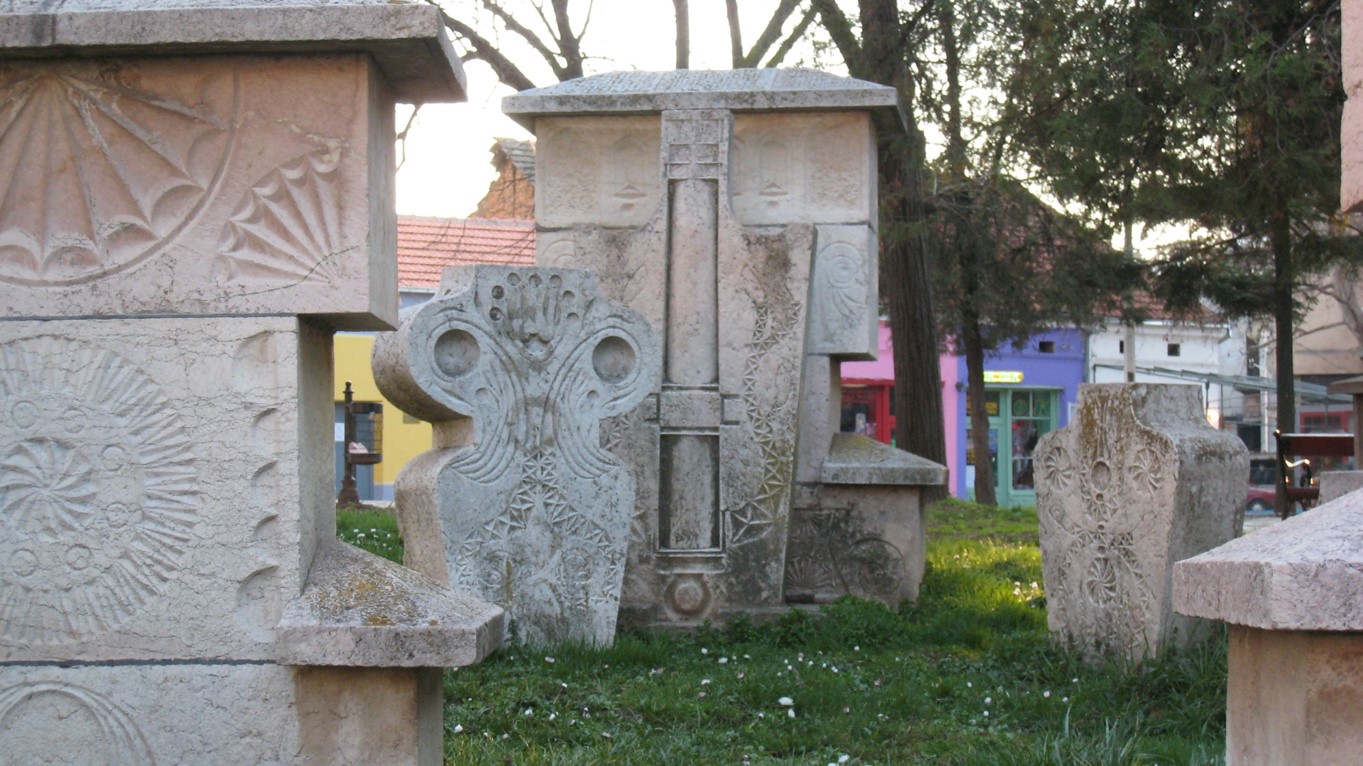 Memorial to the Fallen of the Wars of Independence between 1804 – 1945, Knjaževac (1971). Photo: Ivan Ristić
Memorial to the Fallen of the Wars of Independence between 1804 – 1945, Knjaževac (1971). Photo: Ivan Ristić
The mythological amphisbaena (a serpent with a head at each end), was one of Bogdanović’ favourite motives. She represents the basic idea of ambiguity as well as continuity.Amphisbaenae also occur on the cenotaphs for the Victims of Fascism in Travnik (Bosnia) which was badly damaged during the war in the 1990s. One might argue that thus they were transformed into remnants of a vanished civilisation, thus representing a self-fulfilling prophecy. At some point Bogdanović got very fascinated by this condition of the monument, so he even made an unofficial proposal to keep the cenotaphs preserved in this condition.
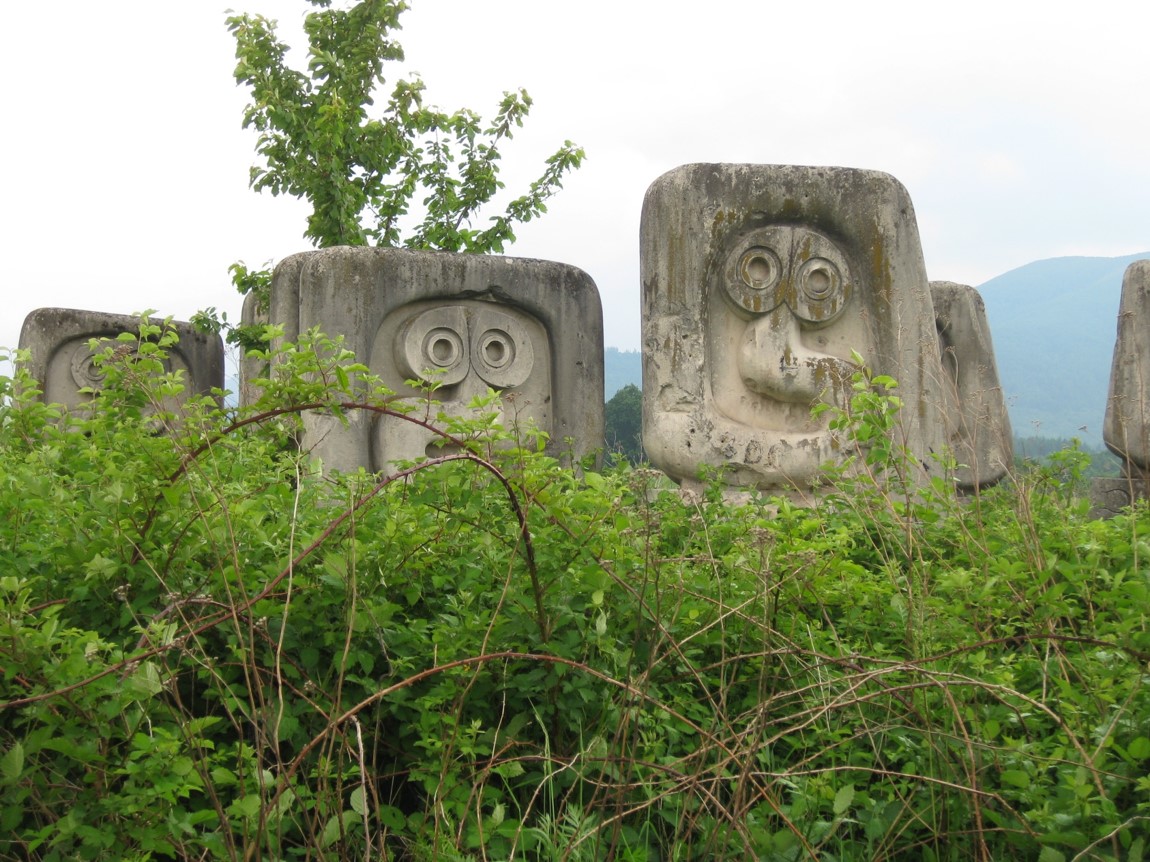 Cenotaphs for the Victims of Fascism, Travnik (1975). Photo: Ivan Ristić
Cenotaphs for the Victims of Fascism, Travnik (1975). Photo: Ivan Ristić
Palimpsests are something I have already hinted to by talking about drawing “post-factum”, drawing afterwards. What I am talking about are many layers of a single drawing – those were made mostly for the Cenotaphs of Vukovar in Croatia. This is a place on which several dozens of anti-fascists had been executed between 1942 and1945 by the Croatian Ustaša. Vukovar is a city in Croatia which was completely destroyed in the 1990s. The memorial is also in a very bad condition. The drawings made for Vukovar bear testimony that Bogdanović worked in many layers by drawing and redrawing, so it is quite a fluid development. He also developed a metaphor of a sunken city, inspired by Goethe and his visit to Pozzuoli, wherein the prominent German traveller made an analysis of a sunken temple covered by lava stones. This would make an inspiring link to Robert Smithson’s “Spiral Jetty”, one of the most distinguished works of what we call the Land Art. The point is that the “Spiral Jetty” often disappears and re-emerges under the water surface, which depends of meteorological conditions. This is also something which repeatedly happens to the sunken city in Bogdanović’s drawings – on a metaphorical level of course. In the lower part of Dudik Memorial Park we see the so-called “šajke” (boats) referring to the naval tradition on the Danube. As if the boats were leaving the sunken city. Once again Bogdanović developed a very poetical concept.
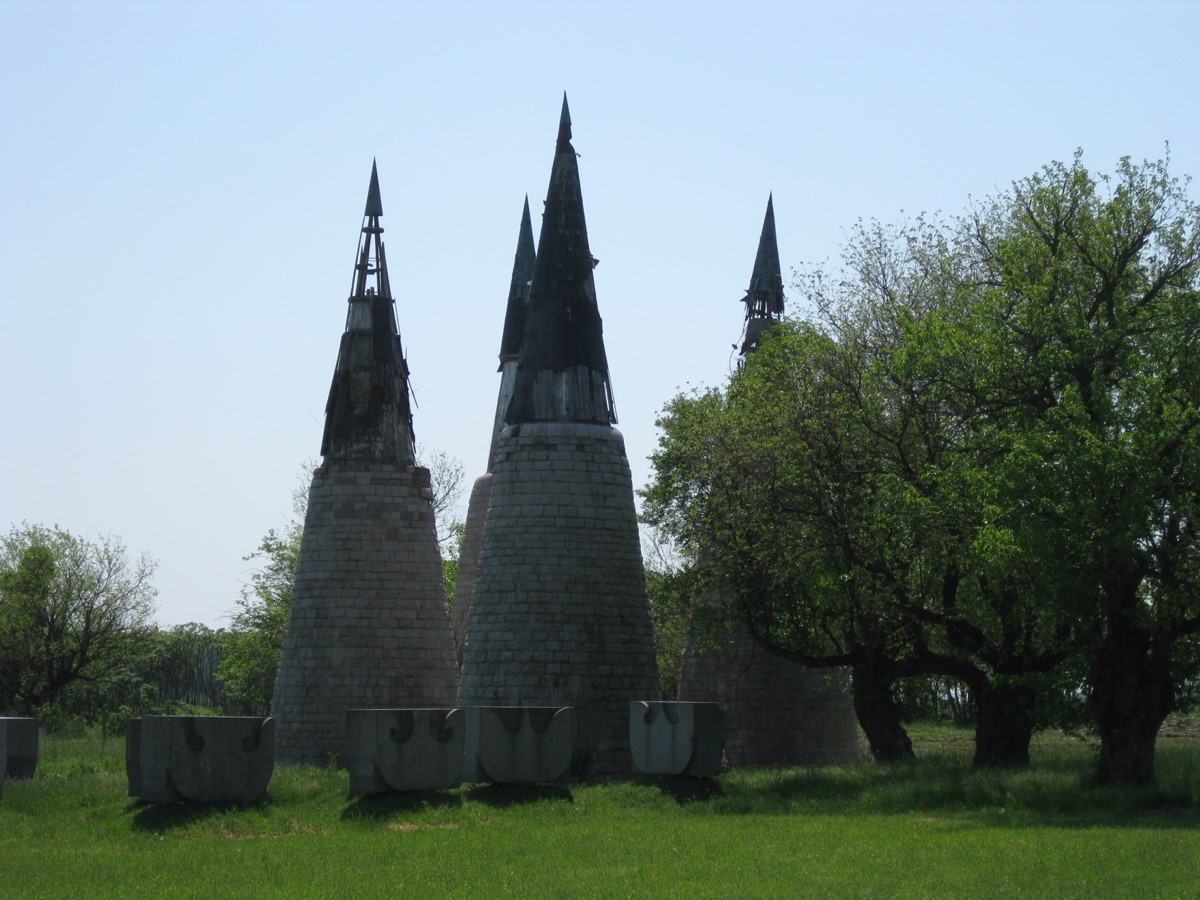 Dudik Memorial Park, Vukovar (1980). Photo: Ivan Ristić
Dudik Memorial Park, Vukovar (1980). Photo: Ivan Ristić
The very last monument is the Combatants Mausoleum in Popina, Serbia (1981). You may have noticed that Bogdanović loved the ornament, which was quite unusual attitude for a presumptive modernist. The very last monument did not have any ornaments. Paradoxically it became an ornament in itself, being a sign in the nature. This is something that many contemporaries would not comprehend. Many of the art theorists who had criticized Bogdanović for his ornaments for decades stated after its completion that he at last “came to his senses” by giving up the ornament. Apparently it didn’t come to their minds that it was quite an esoteric matter once again.
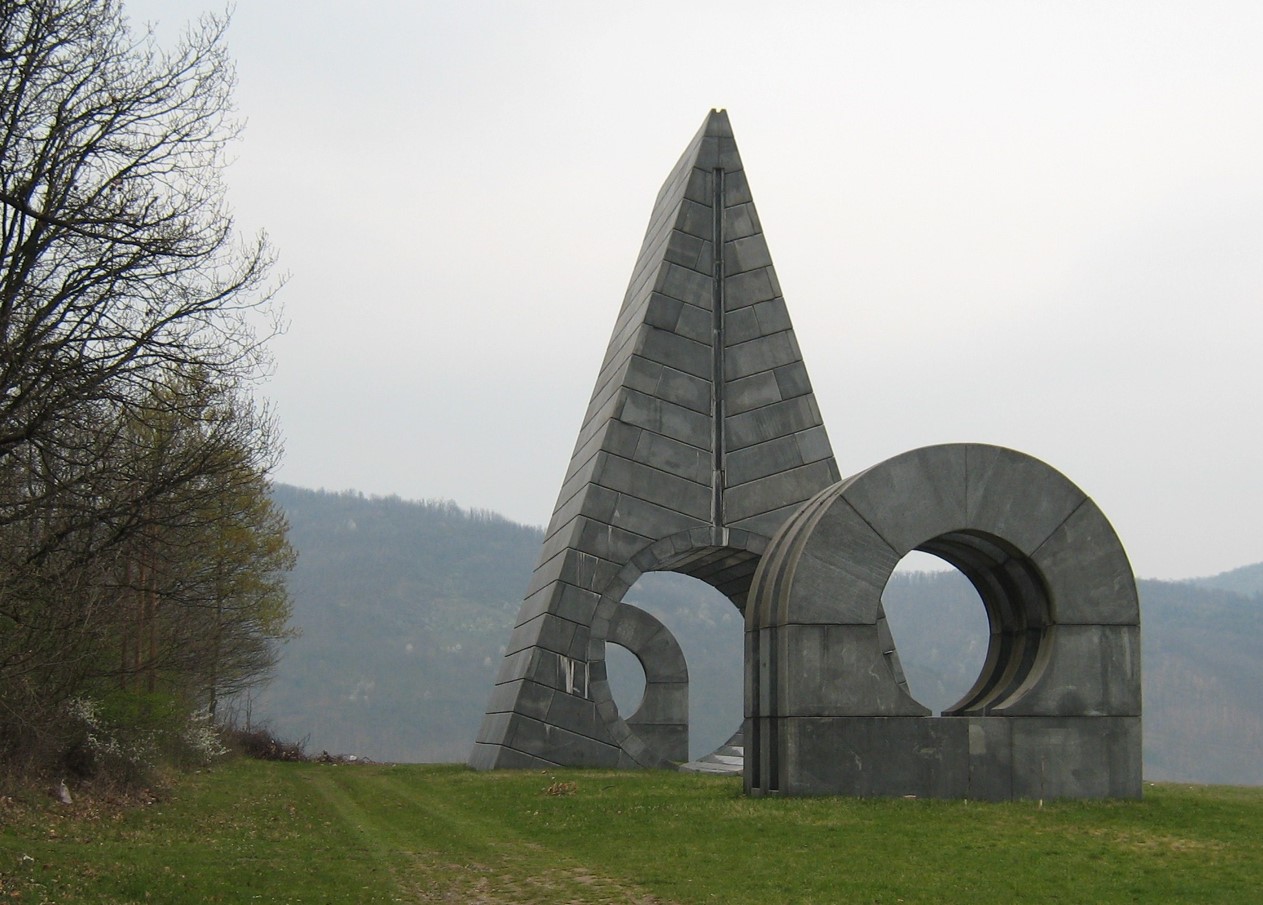 Combatant’s Mausoleum, Popina (1981). Photo: Ivan Ristić
Combatant’s Mausoleum, Popina (1981). Photo: Ivan Ristić
So this was an overview more or less, so let’s talk about dissidence in architecture, why he was a dissident.
Ines Weizman: We should not impose this too much, sometimes we might not even know the exact details where dissidence lies in. I imagine the whole point about the secrecy, bringing in only last minute the execution plans, so only the last minute it was decided. Or he was inviting particular craftsmen to treat the stone. So he finally built into the very structures the unexpected. It was also a certain liberty for the stone masons…
Ivan Ristić: It was a refusal of everyday practice, which was probably linked to the socialist building practice in general and we cannot talk about Bogdan Bogdanović as a dissident, but we can talk about the dissidence of Yugoslavia as a whole within the corpus of socialist countries. I consider this a main point, because it was the very society which encouraged him to develop this kind of aesthetics. This would not have been possible without Tito’s famous break with Stalin in 1948, of course. The new socialist society was faced to this challenge of developing a new formula of commemorating the victims of fascism and the partisans.
I. W.: If you look at the work we have seen, there are a lot of archaic gestures, referral to partly esoteric, but also the tradition of primordial forms, objects, figures. How do we define then his modernism?
I. R.: The best definition of Bogdan Bogdanović was given by an architecture critic from Austria, Friedrich Achleitner. He calls Bogdanović an anti-modernist. But in order to become an anti-modernist, you have to go through a modernist phase. This is what Bogdanović really went through in the beginning. So the aim was actually to overcome modernism.
I. W.: Can you project forward a bit? Because you leave now with 1981. I think it is also important for the audience to understand what happens now. It is quite critical [time], because he becomes a mayor of Belgrade. What’s actually happening in the years up to come, until 1993?
I. R.: Bogdanović was a member or even a functionary of the Communist Party. But it is important to stress that Serbian Communist Party consisted of two different groups, two different wings – the neo-Bolshevist wing, you may even call it a neo-Stalinist wing, and the other one, which was liberal and pro-western, which was ready to talk about everything – even about the possibilities of establishing a new political system. It is really important to stress that Bogdanović was representative of this liberal wing of the Communist Party. He was appointed mayor of Belgrade by representatives of this liberal wing. This is a very important part of the explanation. We have to differentiate between communists and communists.
I. W.: How did he appear as an architect politician when he was a mayor?
I. R.: Well, he did try to intervene, to act as an architect. For example, he initiated an international tender for redeveloping and restructuring New Belgrade, which is a huge part of the city planned by socialist economy in the post-war period. He wanted to create a new urban scheme, so he invited numerous architects from all over the world, however he failed. The competition was won by a Slovakian team but their plans never came to realisation. This is something I can vividly recall: a mayor acting as an architect.
I. W.: Because I read a little bit more how eccentric he actually was. Sort of an artist appearing on rather a bureaucratic stage.
I. R.: …wearing a scarf and looking like a bohemian. He was completely different than everybody else in the Communist Party. But obviously this very Communist Party needed such characters for purely representative purposes.
I. W.: So what happened then?
I. R.: We should consider the image and the connotations of such appearance in public space. Bogdanović was also the founder of “Alternative School for Philosophy of Architecture”. It was something like a hippie commune back in the 1970s. Of course many representatives of the establishment were sceptical towards this kind of experiment, but he managed to develop a very interesting concept by working with his students in the course of these lessons, designing urban schemes by referring to pre-historical and ancient civilizations, primeval techniques, etc. – it is a further aspect of his activity. I also have to stress that he was backed by the top representatives of the Communist party, whereas he did have conflicts and misunderstandings on a lower political level.
I. W.: In the monuments, there is a fine play he is trying… we are still… Tito dies when?
I. R.: 1980.
I. W.: 1980. So the whole idea of these cemeteries is a very fine play with combining also various ethnicities into Yugoslav context, right?
I. R.: On a supra-national level, of course.
I. W.: It’s again kind of breaking up into nationalities, which then happens I guess with Milošević. Maybe you could mention a bit about this too… moments where he starts to change his role basically from the kind of architect-politician, his departure from politics.
I. R.: On the 8th congress of Serbian Communist Party in 1987, the Bolshevist wing prevailed and Bogdanović and his friends were more or less overthrown. This is what made him write a letter to the Central committee of the Communist Party, in which he basically analysed its neo-stalinist language, not the policy. He applied an extremely thorough method and many people could not really understand what the content of that letter was, but still, he was someone who publicly opposed the new bolshevist tendencies, so he was thrown out of the party. This is how he became a dissident in a “classical” sense only at a very late stage. It all happened in the late 1980s, just few years before the decline of communist regimes in Eastern Europe. Simultaneously he criticized nationalist tendencies within the regional communist parties. The biggest bolshevists turned out to be the biggest nationalists – not only in Serbia – and this is what led to war conflicts in the rest of Yugoslavia. This is something he was consequently opposed to from the very beginning.
I. W.: It’s fascinating to go into this, but maybe we should also open it up. We should also mention the books that came later, which you could say also was one era of political dissidence, when he decided to write.
I. R.: He had written a number of books before, like for example “Futile Trowel” published in 1963 and misunderstood by most of the readers. For his contemporaries from architecture sphere, Bogdanović was much too esoteric and playful, whereas for common reader he was too ‘high-brow’. This is why I talk about ‘being respectfully ignored’. He began writing books as soon as in 1950s, but he wrote some of his most important books in 1990s, in which he mainly criticized the nationalism and its effects by reflecting on the destiny of the city, as he always argued that the city destroyers were actually the biggest criminals in ex-Yugoslavia. If you want to destroy a culture, you have to destroy a city. It’s not by chance that we are talking about synonyms – civitas is culture, or civilization, and the city at the same time. This was exactly what he referred to. He also considered a city a “person” with its habits, customs, psychology, eroticism and all the other features belonging to the compendium of a so-called identity. Eventually Bogdanović he was forced to leave Belgrade and to settle down in Austria in 1993.
I. W.: Can you tell us a bit more about him as an educator?
I. R.: He was the most popular professor on the faculty of architecture in Belgrade due to his unconventional teaching methods. He gave lectures about the history of the city in the 1960s. Later he was also the dean of that faculty. In this function he tried to reform the university in the early 1970s according to some devices which have much in common with today’s Bologna system. But he failed, as the criticism from the Communist Party was much too strong. He also had to face criticism which came from his own colleagues, so he actually had to resign as dean. Couple of years later he decided to found an esoteric school outside of Belgrade for smaller circle of students. This is probably how he became a dissident within the architectural practice before becoming a political dissident.
I. W.: When was it, the Village school?
I. R.: He gave some initial courses, called “The symbolical shapes” from 1973 and he settled down with this course in a remote village in 1976. It existed until 1990 and it was demolished by some policemen who were probably engaged by Slobodan Milošević.
I. W.: Thank you very much Ivan, it was a wonderful talk.




